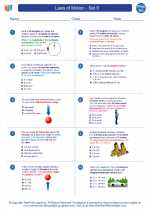Velocity
Velocity is a vector quantity that describes the rate at which an object changes its position. It is a measurement of both the speed and the direction of motion of an object.
Formula for VelocityThe formula to calculate velocity is:
Velocity (v) = Displacement (Δx) / Time (Δt)
where Δx is the change in position and Δt is the change in time.
Units for VelocityThe SI unit for velocity is meters per second (m/s). It can also be expressed in other units such as kilometers per hour (km/h) or miles per hour (mph).
Types of VelocityThere are different types of velocity, including:
- Instantaneous Velocity: The velocity of an object at a specific instant in time.
- Average Velocity: The total displacement of an object divided by the total time taken.
- Uniform Velocity: When an object travels in a straight line and its velocity remains constant.
- Non-Uniform Velocity: When an object's velocity changes over time, either in speed, direction, or both.
To calculate the velocity of an object, you need to know the initial and final positions of the object and the time taken to move between those positions. Use the formula v = Δx / Δt to find the velocity.
Graphical RepresentationVelocity can be represented on a displacement-time graph. The slope of the graph represents the velocity of the object. A steeper slope indicates a higher velocity, while a shallower slope indicates a lower velocity.
Here is an example of a displacement-time graph:
 Displacement-Time Graph" style="width:400px;height:300px;">
Displacement-Time Graph" style="width:400px;height:300px;">
When studying velocity, it's important to understand the following key concepts:
- Understanding the difference between speed and velocity.
- Knowing how to calculate velocity using the formula v = Δx / Δt.
- Recognizing the units of velocity and how to convert between different units.
- Being able to interpret and analyze displacement-time graphs to determine velocity.
- Understanding the various types of velocity, such as instantaneous, average, uniform, and non-uniform velocity.
Practice problems involving velocity calculations and interpreting displacement-time graphs will help solidify your understanding of this topic.
Remember to pay attention to the direction of motion when dealing with velocity, as it is a vector quantity and requires both magnitude and direction for a complete description of an object's motion.
Feel free to reach out if you have any further questions about velocity or any other physics topics!
.◂Physics Worksheets and Study Guides High School. Laws of Motion - Set II

 Worksheet/Answer key
Worksheet/Answer key
 Worksheet/Answer key
Worksheet/Answer key
